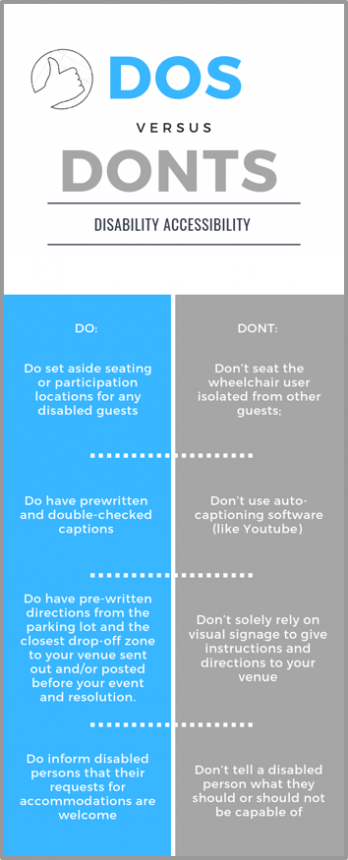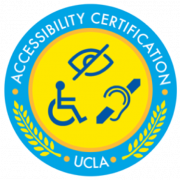Making UCLA Accessibility Conscious
Every time I go on my Facebook, I see new events being held for movie screenings, networking events, and panels, all of which I am eager to participate in and learn more about. At these events, I interact and meet others with similar interests, providing the basis of many friendships and connections. I see them as opportunities to enhance my social well-being.
Unfortunately, for many students with disabilities, these events and activities are difficult to participate in: the tables at an event may be too high for a student in a wheelchair to reach, an interpreter may not be present so that hard of hearing and Deaf students with listening impairments are unable to understand what is going on, or pathways obstructions may impede a person who is blind’s ability to travel. Since students with disabilities compile only a small percentage of the UCLA body, planners often forget or simply don’t know how to incorporate disability-friendly measures into their events.
Carolanne “Goob” Link, a former undergraduate student at UCLA who was born with cerebral palsy, navigated campus as a student with mobile disabilities. The extra hurdles she experienced in order to attend events and activities at UCLA inspired the creation of the Campus Accessibility Toolkit.

The Campus Accessibility Toolkit arms and educates event planners with the vital information, through research and anecdotal evidence to create resource guides and lists, to make their events accessible to students with physical disabilities.
The Drive for the Creation of the Accessibility Toolkit
Goob’s two distinct experiences, as an ambulatory mobility impaired studentand as a student in a wheelchair, sparked Goob’s interest in disability culture. Although she recognized an abundance of resources on campus, like the Center for Accessible Education (CAE), the ADA/504 Compliance Office, and the Disabilities and Computing program to help disabled students succeed academically, Goob explained that the services those resources provide “doesn’t necessarily mean you feel comfortable with experiences outside of the classroom. UCLA could be doing more to help include disabled person in extracurricular activities.”
If social events do not take in account accessibility concerns, discomfort ensues, burdening both the student with disabilities and the event planners. Whenever she attended an event, her first thought was always “Is there going to be a problem?,” often correctly anticipating that appropriate accessibility concerns had not be made. While she felt ostracized for not being able to experience the event the way it was supposed to be experienced, she also acknowledged the guilt and regret event planners felt when they realized that their events were not universally attendable. Goob hopes that the contents of the Campus Accessibility Toolkit will “help students with disabilities feel more included and not have a fear of going to an extracurricular activity and for planners to not feel anxiety about planning for someone with a different set of needs.”
A big obstacle in making social events accessible stems from a lack of communication between event planners and students with disabilities. When Goob attended a panel for disability studies, questions like “How do you ask about the disability?” and “How do you offer help without being pushy?” astonished her. People could not plan to make their events and spaces more accessible because they did not want to risk the possibility of offending the disabled community. They gravitated to the panel because they believed it to be the only space where their questions would be welcomed and answered. Goob hopes that the Campus Accessibility Toolkit will “bridge this gap by putting knowledge out there without any awkwardness, without any confrontation or possibility of offense.”
The Future Evolution of the Toolkit
Goob has been working on the Campus Accessibility Toolkit for six months, but she has been actively involved in improving accessibility for well over a couple of years. She communicated with a diverse group of sources: students, faculty members, and organizations in order to write the toolkit. Although the Campus Accessibility Toolkit is is currently in beta mode and being edited and modified, a number of offices at UCLA, like the CAE, the EDI, and the ADA504 agreed to feature the toolkit as a resource once it comes out.
Goob has ambitious goals for the Campus Accessibility Toolkit. She is currently in the process of designing an Accessibility Conscious Seal, an emblem event planners can use in their publicity documents to inform the public they have taken measures to make their events as accessible to everyone as possible. The Seal will allow students with disabilities to “know that the planners have already thought about the bigger picture of inclusion.”
Although Goob authored most of the documents available in the Campus Accessibility Toolkit, she emphasized that it is a “living project” and that “my voice is that of a specific person and is the glorified compiler of her and other disabled students’ experiences. This is not some end-all, be-all. I hope that the future generation will become contributors and are always updating the toolkit as the technology changes.” As such, she encourages people to read and continuously add information to the toolkit, envisioning the development of a hub of information, connecting past difficulties to future solutions. People like event planners, architects and policy makers will be able to read about how to make specific venues on campus accessibility friendly.
After reading the Campus Accessibility Toolkit, I realized just how little I knew about a certain subset of people of UCLA. It never occured to me how unfair it was that the events that I attend on a weekly basis could not be enjoyed by everyone.
Be sure to check it out below:
Jessica Yang is a second year student majoring in Environmental Science with a concentration in Environmental Health. On top of blogging for Semel HCI, she is part of club swimming and hopes to pursue a career in healthcare in the future.

